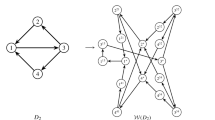Abstract
To avoid signal interference in mobile communication it is necessary that the frequencies used for communication within each cell are allocated so that no signal interference occurs with neighbouring cells. We model this channel allocation problem as a generalised list colouring problem and we show how to analytically measure and provide worst-case guarantees regarding request satisfiability. To the best of our knowledge, this has not been done before and gives a new perspective to the problem, as well as a clear direction for further investigation. We propose distributed approaches for solving the problem, which are able to adapt fast to temporal variations in channel demands in different cells, as well as to cope with crash failures, by limiting the failure-locality – the size of the network that can be affected by a faulty station, in terms of the distance from that station. Our first approach is inspired by a relatively recent theorem relating graph colourings and orientations; it achieves the equivalent of the best known sequentially achievable upper bound for request satisfiability, implied by the theorem. It also employs a powerful synchronisation mechanism to achieve worst-case response time that depends only on Δ – the degree of the signal interference graph – and failure locality 4. Our second proposal is a first approach towards exploring what bound in request satisfiability is achievable without the use of extra synchronisation; by employing randomisation in frequency choices, in only one round of communication, a base station can expect to pick f/(4Δ) frequencies, where f is the size of the list at the node; the failure locality of this solution is only 1.
Similar content being viewed by others
References
N. Alon and M. Tarsi, Colourings and orientations of graphs, Combinatorica 12(2) (1992) 125–134.
B. Awerbuch, A. Goldberg, M. Luby and S. Plotkin, Network decomposition and locality in distributed computation, in: Proceedings of the IEEE 30th Symposium on Foundations of Computer Science (1989) pp. 364–369.
B.R. Badrinath, A. Acharya and T. Imielinski, Impact of mobility on distributed computations, Operating Systems Review 27(2) (April 1993).
V. Barbosa and E. Gafni, Concurrency in heavily loaded neighbourhood constrained systems, ACM Transactions on Programming Languages and Systems 11(4) (October 1989) 562–584.
D. Bertsekas and R. Gallager, Data Networks (Prentice Hall International Editions, 1987).
M. Biró, M. Hujter and Z. Tuza, Precoloring extensions. I. Interval graphs, Discrete Mathematics 100 (1992) 267–279.
K.M. Chandy and J. Misra, The drinking philosophers problem, ACM Transactions on Programming Languages and Systems 6(4) (October 1984) 632–646.
M. Choy and A. Singh, Efficient fault tolerant algorithms for resource allocation in distributed systems, ACM Transactions on Programming Languages and Systems 17(3) (May 1995) 535–559. Also in: Proceedings of the 24th ACM Symposium on Theory of Computing (1992) pp. 593–602.
J.C.-I. Chuang, Performance issues and algorithms for dynamic channel assignment, IEEE Journal on Selected Areas in Communications 11(6) (August 1993) 955–963.
P. Erdös, A.L. Rubin and H. Taylor, Choosability in graphs, in: Proceedings of the West Coast Conference on Combinatorics, Graph Theory and Computing (Congr. No. 26) (1979) pp. 125–157.
S. Ghosh and M.H. Karaata, A self-stabilising algorithm for colouring planar graphs, Distributed Computing 7 (1993) 55–59.
T. Hagerup and C. Rüb, A guided tour of Chernoff bounds, Information Processing Letters 33 (1989/1990) 305–308.
S.G. Hild, A brief history of mobile telephony, Technical report No. 372, University of Cambridge, Computer Laboratory (January 1995).
G. Ioannidis, Mobile computing, PhD Thesis, Columbia University (1992).
T.R. Jensen and B. Toft, Graph Colouring Problems, Wiley-Interscience Series in Discrete Mathematics and Optimisation (Wiley Interscience, 1995).
E. Malesinsca, An optimisation method for the channel assignment in mixed environments, in: Proceedings of ACM MobiCom'95. Also available as Technical report No. 458/1995, Fachbereich Mathematik, Technische Universität Berlin (1995).
R. Prakash, N.G. Shivarati and M. Singhal, Distributed dynamic channel allocation for mobile computing, in: Proceedings of the 14th ACM Symposium on Principles of Distributed Computing (1995) pp. 47–56.
H.-U. Simon, The analysis of dynamic and hybrid channel assignment, Technical report, Universität des Saarlandes, SFB144-B1 (1988).
C. Thomassen, Every planar graph is 5-choosable, Journal of Combinatorial Theory, Series B 62 (1994) 180–181.
M. Voigt, List colourings of planar graphs, Discrete Mathematics 120 (1993) 215–219.
Author information
Authors and Affiliations
Rights and permissions
About this article
Cite this article
Garg, N., Papatriantafilou, M. & Tsigas, P. Distributed Long-Lived List Colouring: How to Dynamically Allocate Frequencies in Cellular Networks. Wireless Networks 8, 49–60 (2002). https://doi.org/10.1023/A:1012719525108
Issue Date:
DOI: https://doi.org/10.1023/A:1012719525108




